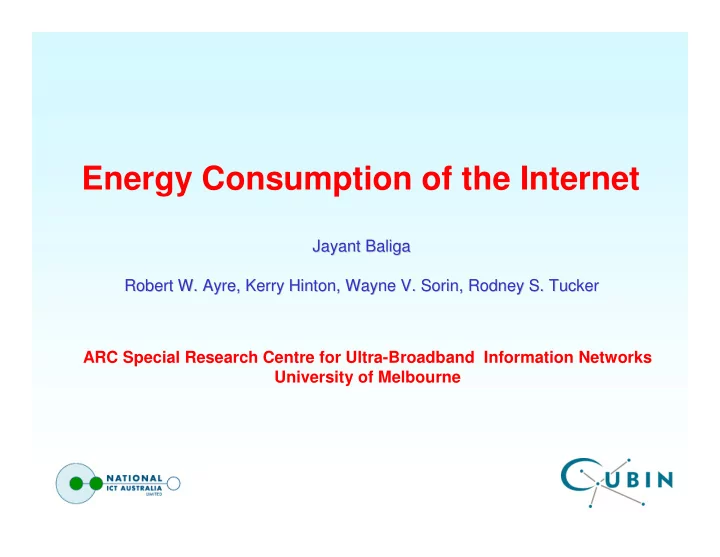

Energy Consumption of the Internet Jayant Baliga Jayant Baliga Robert W. Ayre, Kerry Hinton, Wayne V. Sorin, Rodney S. Tucker Robert W. Ayre, Kerry Hinton, Wayne V. Sorin, Rodney S. Tucker ARC Special Research Centre for Ultra-Broadband Information Networks University of Melbourne
Energy and the Internet Core Network IPTV Network Data Access Metro/Edge Center Network Network Why is Energy Important? • Operational Expenditure (OPEX) • Greenhouse Impact • Energy-limited capacity bottlenecks (“hot spots”)
Calculating Energy Consumption of the Internet • • A model to estimate energy consumption of the Internet A model to estimate energy consumption of the Internet – Core, metro, and access networks • Where does the energy go? • Where does the energy go? • • What happens as traffic grows? What happens as traffic grows? • Towards an energy efficient Internet • Towards an energy efficient Internet
Network Energy Model Tier 1 Full-Service ISP Network Metro/Edge Network Core Network Access Network Fiber Broadband Core Router Network DSLAM Cu Gateways Ethernet DSL Switch EDFA Cabinet Edge Fiber Routers OLT OXC PON Splitter Cabinet Cu OLT FTTN DSLAM ONU Switch Fiber PtP Server Server Storage Storage IPTV Network Data Center
Estimating Energy Consumption • • Choose an access data rate (capacity per user) Choose an access data rate (capacity per user) • Carry out paper design of network • Carry out paper design of network • • Calculate the power consumed by the network per user Calculate the power consumed by the network per user • Repeat for all access rates • Repeat for all access rates Oversubscription ~ 2.5 Mb/s in 2008 Peak access rate sold to user M = M = 25 Capacity per user ~ 0.1 Mb/s in 2008
Power Consumption of IP Network 25 2008 Technology 10 core hops Oversubscription = 25 1.0 20 % of Electricity Supply Power (W/user) Today’s Internet Total 15 (~ 2.5 Mb/s) Routers 0.5 10 Access (PON) 5 Transmission Links 0 0 50 100 150 Peak Access Rate (Mb/s) Baliga et al., 2008
Power Consumption in Access Networks Wave7 ONT-G1000i Access N/W Cabinet GPON Fiber Splitter Edge Node NEC VF200F6 Cabinet Hitachi 1220 Cisco FTTN 6513 Splitter Cu VDSL2 NEC AM3160 TC Communications TC3300 Cisco 4503 PtP Fiber Axxcelera Hitachi 1220 Axxcelera ExcelMax ExcelMax BTS WiMAX Cisco Fiber uBR10012 RF Node Gateway Cisco DCP3000 Cu HFC RF Amp
Power Consumption in Access Networks 30 20 users per sector M = Oversubscription M= 10 WiMAX Power Per User (W) 20 FTTN M = 1 PtP M = 1 M= 1 M= 10 10 32 Customers M = 32 PON HFC M = 1 0 1000 1 100 10 Peak Access Rate (Mb/s) PON FTTH is “ PON FTTH is “greenest greenest” ”
Some Observations • Access network dominates at low rates • Access network dominates at low rates • Network routers dominate at higher rates Network routers dominate at higher rates • • • Transmission Links consume a small percentage of the total Transmission Links consume a small percentage of the total power power • Possible approaches to controlling growth in energy • Possible approaches to controlling growth in energy consumption: consumption: – Improve electronic technology – New architectures (Optical bypass) – New protocols (“low energy” states)
Router Capacity Growth CRS-1 10000 Router capacity x 2.5/18 m (~1.3 Tb/s,13.6 kW/rack) 12416 X 1993 Performance (~0.3 Tb/s/rack) 1000 Moore’s law x 2/18 m 12016 CMOS energy efficiency x 1.65/18 m (~80 Gb/s/rack) 100 30% p.a. 10 Router energy efficiency improving at 20% p.a. Neilson, JSTQE 2006 1 1994 1996 1998 2000 2002 2010 2004 2006 2008 Based on G. Epps, CISCO, 2006 Year
The Energy Bottleneck • • Router energy consumption is reaching the limits of air cooling Router energy consumption is reaching the limits of air cooling – Cisco CRS-1 (largest core router available) X2 every 18 months Per Rack Neilson, 2006 & Deutche Telekom, 2007
Effect of Efficiency Gains? 25 2008 Technology 1.0 20 % of Electricity Supply Power (W/user) Total 15 Routers 0.5 10 Access (PON) 5 Transmission Links 0 0 50 100 150 0 Peak Access Rate (Mb/s) Baliga et al., 2008
Improvements in Technology Efficiency 25 Traffic Growth rate = 40% p.a Overall Technology Efficiency 1.0 20 Total Power (W/user) % of Electricity Supply Improvement Rate = 0% p.a 5% p.a 15 10% p.a 0.5 10 20% p.a Target 5 0 0 50 100 150 0 Peak Access Rate (Mb/s) Baliga et al., JLT 2009
Improvements in Network Architecture Optical Bypass Optical Bypass Source Destination Router Bypass Bypass X-connect 1.0 20 % of Electricity Consumption Efficiency Improvement Rate = 10% p.a. Total Power Per User (W) No bypass 0.75 15 Bypass 0.5 10 Access 5 0.25 0 0 1 300 100 10 Baliga, et al, JLT 2009 Peak Access Rate (Mb/s)
Summary – Where to in the Future? • • Energy consumption of the Internet is small (0.4%), but will Energy consumption of the Internet is small (0.4%), but will approach 1% in the future approach 1% in the future • Internet energy consumption dominated by • Internet energy consumption dominated by – Access network today – Core network in the future • • A multi A multi- -disciplinary approach is required to build a green disciplinary approach is required to build a green Internet: Internet: – Improved efficiency in electronic and photonic devices – Improved architectures
Recommend
More recommend